Analyzing Intel Core M Performance: How 5Y10 can beat 5Y71 & the OEMs' Dilemma
by Brett Howse & Ian Cutress on April 8, 2015 8:00 AM ESTClosing Thoughts
There is a lot to say about Core M performance. We have tested three very different devices, all with Core M inside - each device tackles the design philosophy of Core M from different directions, and it comes across in the results based on where each device stands. We started this analysis to answer the question "how can 5Y10 beat 5Y71?', and the results answer that quite clearly.
Dell Venue 11 Pro 7000 (5Y71)
Starting with the Dell Venue 11 Pro 7000, this is an 11 inch tablet with passive cooling and a small chassis. The plastic exterior helps with skin temperature, but hinders the ability of the device to radiate the heat that it generates.
This chart shows where Intel believes Core M can be done in a passivly cooled device, and it assumes a metal chassis which the Venue 11 Pro 7000 lacks. Device thickness, material, and chassis size all play a big factor in how much heat can be dissipated. Under sustained use, the Venue 11 Pro can get warm to the touch, but as seen in the previous pages the actual SoC temperature can spike very rapidly. This compromises performance, although everything is relative. Compromised Core M CPU performance is still quite a bit more powerful than a Silvermont core in an Atom.
Lenovo Yoga 3 Pro (5Y71)
The Yoga 3 Pro on the other hand is a convertible tablet, and is the only Core M device in our test with active cooling. Lenovo has gone to great lengths to ensure that it does not get hot in the hand, since it most certainly can and will be used when held. It has the lowest SoC temperature of any of the devices by quite a bit, although it is of course helped by the inclusion of a fan. Lenovo has clearly set a target SoC temperature of 65°C as the maximum they are comfortable with in order to keep skin temperatures where they want them. It does not really hurt the device in all workloads, and as we have seen the Yoga 3 Pro can even outperform a Core i5-5200U in cherry-picked scenarios. On sustained maximum performance though, the lower SoC temperature means that the CPU and GPU must cut back sooner than the other devices, which limits performance.
ASUS Zenbook UX305 (5Y10)
The ASUS Zenbook UX305 is a completely different device. It is a laptop, so skin temperatures are not as big of a concern, and while it does get hot at around 48°C on long workloads, that heat is well away from where you would normally be touching the device. Also, being made out of aluminum is clearly a huge benefit for a passively cooled device such as this, as it allowed the ASUS to consistently outperform the other Core M devices despite it being the lowest boost frequencies in the test. The performance of the Zenbook was very consistent, even on extended workloads, and on the DOTA 2 test, the Zenbook even outperformed the Latitude, although that was less to do with thermals and more to do with the lack of memory bandwidth on the Dell laptop.
Core M
So with all of this data, what more do we know about Core M? Clearly, Intel’s goal with Core M is to provide excellent performance on short workloads. It has higher boost frequencies than the Core i5-5200U that was included in this test, and it has 4 MB of L3 cache as well compared to 3 MB of cache on the i5. On certain workloads, performance can even surpass the i5-5200U. Race to sleep is not a new idea, but that is what Core M is designed to do, and it does it well. Run on very little power, and then when tasked with work, get it done as quickly as possible and get back to the low power mode. This is not unique to Core M of course, as the Core i5 does the exact same thing, however the much more restrictive thermal envelope of just a 4.5 watt TDP means that sustained workloads just have to suffer compared to a device with a 15 watt TDP.
We did see that happen too. The Core M scored very well in the PCMark 8 benchmarks, which attempt to emulate real world use rather than just performing a single task until it is done. The burst nature of this allowed Core M to have enough time in between work to keep the temperatures in check. On sustained work, this was not always the case.
On the 5Y71 vs. 5Y10 front, we have some clear lines drawn:
| Intel Core M Performance | |||
| 5Y10 Result ASUS UX305 |
5Y71 Result Lenovo Yoga 3 Pro |
5Y71 Result Dell Venue 11 Pro 7000 |
|
| Cinebench R15 ST | 82.14 pts | 90.85 pts | 86.00 pts |
| Cinebench R15 MT | 210.66 pts | 196.00 pts | 175.00 pts |
| PCMark 8 - Home | 2655 pts | 2443 pts | 2606 pts |
| PCMark 8 - Creative | 3056 pts | 3110 pts | 3064 pts |
| TouchXPRT 2014 | 654 pts | 820 pts | 764 pts |
| 3DMark Sky Diver | 2773 pts | 1624 pts | 1820 pts |
| 3DMark Cloud Gate | 4251 pts | 3685 pts | 3753 pts |
| 3DMark Ice Storm | 47527 pts | 49619 pts | 44911 pts |
| DOTA 2 | 34.0 fps | 26.5 fps | 25.2 fps |
It also shows just how much the individual device plays in how much performance is available. The ASUS has by far the best cooling solution of the three Core M devices, which is helped of course by the form factor. Lenovo could not get away with a 50°C surface temperature on a device that can be used as a tablet. It just would not work. The form factor of the Yoga 3 Pro plays against it on sustained workloads. The Dell Venue 11 Pro allowed a much higher SoC temperature, but it would also spike there very quickly. What we would really love to see is the Core M-5Y71 processor inside of the Zenbook to see just how much the increased boost of the 5Y71 compromises the performance on longer duration workloads, if it does.
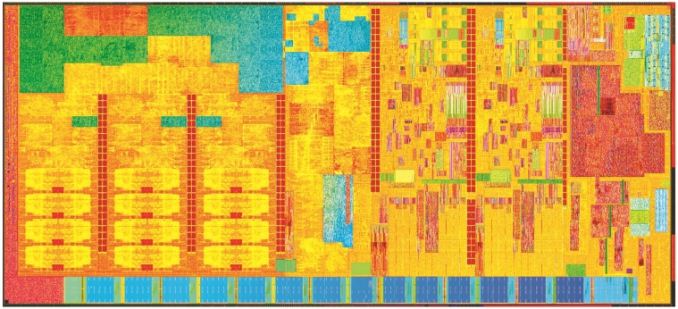
Die Shot of a Core M Processor
Is Core M a good processor? Or is it slow? It is clearly slower than a Core i5, but it would be hard to expect it not to be. On many daily workloads, it performs very well. On things like web browsing we are already to the point where the Yoga 3 Pro outscores a Core i7-860 4C/8T 95 watt desktop CPU from 2009 in web benchmarks. Since Core M is mainly aimed at thin and light devices, it can be expected that these are the kinds of workloads that one would perform on them. Many companies have jumped onboard with the smaller processor, as it allows a thinner and lighter device, and the possiblity of having no moving parts. Core M enables this with a much lower TDP than the next tier of mobile processors from Intel, as well as a smaller overall SoC which is thinner as well.
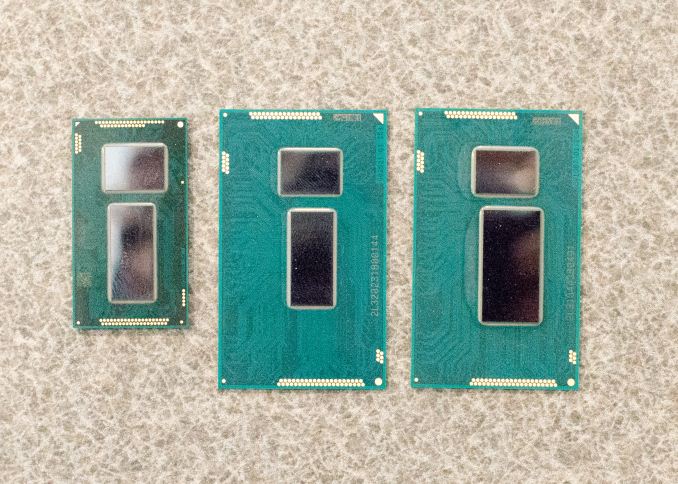 Broadwell-Y (left) vs Broadwell-U (center) vs Haswell-U (right)
Broadwell-Y (left) vs Broadwell-U (center) vs Haswell-U (right)
With the rise of tablets, the migration from hard desktops to smaller form factors has been unprecedented and Core M gives much more CPU performance than any tablet SoC available right now, at the expense of the additional cost the premium product brings. It is well suited to the types of workloads that many of us do during a typical day. There has been a lot of design wins already for this processor, covering a large range of device types and manufacturers. Even Apple has decided that there is a niche where a thinner and lighter version of their laptop may be of good use to their customers.
That said, there are a few other differences that set Core M apart from the mainline Core processors that need to be noted. For example, even though it shares the Gen8 Graphics with the Core i3 / i5 / i7 models in Broadwell-U, it is not quite as capable. It only has software HEVC decode for instance, which means that it might not be suitable for a Home Theatre PC without additional graphics helping out. Gaming is also a scenario where Core M can come up short, but only if you are comparing it to typical PC games. Tablet style games will have no issues, and Core M can perform similarily to other tablets in the GPU department.
In the end, we will quote one of Brett's favorite Formula 1 announcers and author, the great Steve Matchett. Everything is compromise. In Formula 1 racing, each corner of the track would need a different setup on the car for maximum results for that corner, and on the straights you would want most of the car’s downforce removed. Therefore every race and even every corner of a race is compromised for the maximum overall lap speed. The same can be said of Core M. In order to get something as powerful as the Core architecture inside of a fanless tablet, there is going to be compromise. In a Core M device, that is going to be sustained performance. What you give up in sustained performance though allows a thinner and lighter device, in form factors that would never have been possible with Core even one year ago. But it also means that the Core M SKU designation is only a sign of general performance, rather than absolute positioning. For that, we have to compare and contrast each unit in a review. Luckily, we hope to cover a large number of the important models over the next few months.



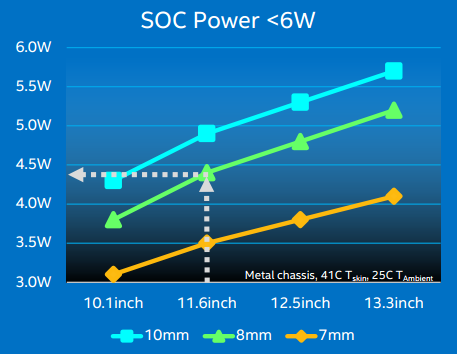
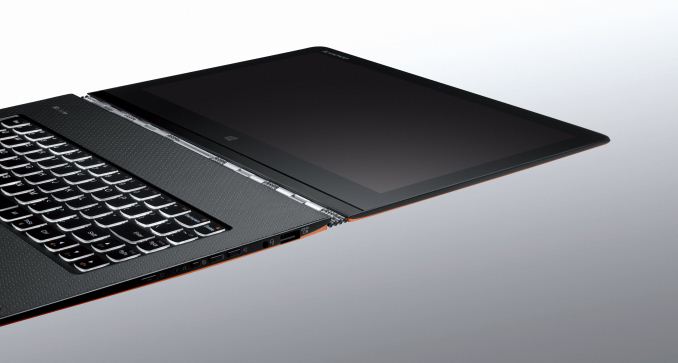
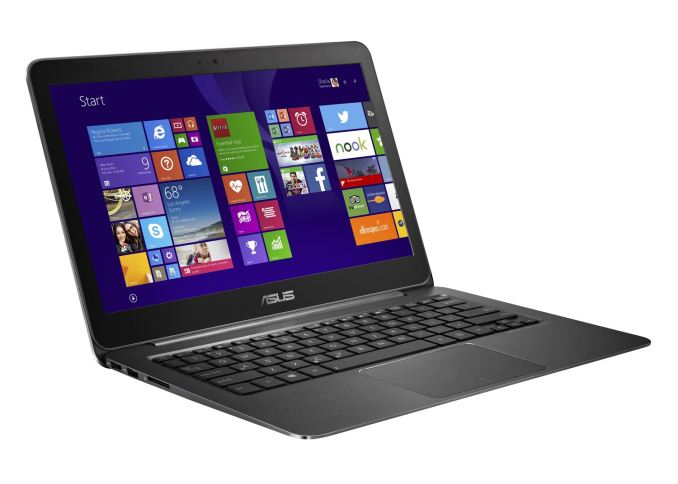








110 Comments
View All Comments
seapeople - Thursday, April 9, 2015 - link
Won't an over-aggressive turbo actually decrease performance? Processors are generally less power efficient at higher clock speeds, i.e., running at 3GHz is twice as fast as 1.5GHz but generally uses more than 2x the power, and thus more than 2x the heat.In this case, therefore, a processor that races to 3GHz will quickly (and less efficiently) use up its thermal headroom and have to throttle back moreso than a processor that stayed at 2GHz.
It's like a footrace - if the race is 100m long, you're going to finish fastest if you go all out. However, if the race is a mile long, then the guy who starts off sprinting is going to be sputtering along a quarter of the way into the race as the joggers pass him up.
MrSpadge - Friday, April 10, 2015 - link
You are right that with agressive Turbo the chip is running in a less power efficient state initially and will have to throttle a bit earlier than a slower, steadily running chip. but if we're talking about low performance under sustained loads, this doesn't matter: it affects the first few seconds, or 10's of seconds at most, whereas in the following minutes both systems are running at the same power efficient throttled speed, which is basically determined by the system cooling. It's not like the sprinter who's completely exhausted and can't recover.retrospooty - Wednesday, April 8, 2015 - link
I dont think its really all that complicated... If you are looking for raw performance, Core M isnt for you. It is really for low power devices that do basic stuff like browsing, email etc. For that purpose, its one hell of a CPU. That performance level at 4.5 watts is a hefty accomplishment IMOYuLeven - Wednesday, April 8, 2015 - link
I do development on a Core M machine. Instead of carrying 4 pounds of computing power on my back, I let a cloud based development box do the heavy lifting. The plume light Core M notebook is used basically to write the code and give orders to the Dev box. IMHO opinion a far better setup than having scoliosis for the sake of running code locally.mkozakewich - Wednesday, April 8, 2015 - link
It's not for web browsing. That's what Atom is for. A Core-M device is good for all regular core tasks except sustained graphics tasks. I wouldn't get one to game, but it'll be great for anything else.retrospooty - Thursday, April 9, 2015 - link
That is pretty much exactly what am saying. Basic use, core M is fine. Not for high performance requirements.nathanddrews - Wednesday, April 8, 2015 - link
They have taken the exact opposite approach to their SSD design, where they try very hard to offer constant and consistent performance.xthetenth - Wednesday, April 8, 2015 - link
Both make sense from the perspective of increasing perceived speed. With storage, it hanging and being slow is the biggest way it can impact the feel of the device, while processors that trade finishing short tasks much faster for a tiny decrease in how fast they complete long tasks do a lot to achieve a responsive feel.xthetenth - Wednesday, April 8, 2015 - link
Device buyers don't buy devices to get a higher average frequency, they buy things to do what they want without the device holding them up. Look at the benchmarks where the ASUS holds higher average frequencies but the Yoga's higher maximum frequency means it completes tasks faster, and it performs better in the benchmark. That sort of responsiveness is what turbo is for. The time to complete long tasks isn't going to be materially changed but the time to complete short tasks is going to be reduced significantly if the processor can use a quick burst like turbo allows.I'm also pretty sure that most users consider not getting burned by their device a good thing that should continue, incidentally.
StormyParis - Wednesday, April 8, 2015 - link
That's not a real use case though. Real use case is load a page (low CPU), render page (high CPU) read page (low CPU). I don't care how fast my CPU is idling while I'm reading the page, I do care how fast the page renders. It'd be different if I were running simulations.. that's what desktop CPUs are for.